 "QUANTUM SHOT" #224 "QUANTUM SHOT" #224Article by guest blogger M. Christian Good Night America... and Good Luck to us all Welcome our guest blogger M. Christian ("Meine kleine fabrik" is a place where M.Christian (www.mchristian.com ) and s.a. (caferacersociety.blogspot.com) put some of the odd, weird, and wonderful things they've stumbled across or tripped over: art, history, machines, heroes, movies, music, and more. The only rule is that we try and make whatever goes up as unexpected as possible -- just like life.) Accidents happen. No one is immune: Except that these mistakes involved thermonuclear weapons, and could easily have reduced a sizable hunk of this world to a Geiger-clicking pit. While I don’t have the time or the space to list all of them, here’s a sample of nuclear boo-boos guaranteed to make you at least look up the next time a plane scrawls a contrail across the sky, or go fishing.  (images credit: vintagephoto) Just a few years after Oppenheimer and those wacky guys at the Manhattan Project turned a piece of the American desert into a glowing tourist spot, a B-36 putting its way from Alaska to Texas had a slight problem staying in the air. Luckily for the crew they managed to drop their bombs, which fell 8,000 feet, landing with a bang off the coast of British Columbia. Luckily for Canada only the bombs’ high explosives went off, not their nuclear cores. It was a very nice opening shot, a 1950 intro to "nuclear weapons accidents".  Eight years (and several similar accidents) later a bomber from Hunter Air Force Base, Georgia made a severe "oops" when it dropped its cargo of one nuclear device onto the backyard of the Gregg family in South Carolina. Fortunately for the Greggs, and South Carolina, again ONLY part of the bomb that went off was the ordinary component of the warhead which injured six members of that clan and made a nice divot in their garden: a hole 70 feet wide and 30 feet deep. The blast also took out five other houses and damaged a church. For almost irradiating a sizable hunk of the US, the Air Force coughed up $54,000.  One of my favorite atomic butter fingers is the one that almost plays out as a Zucker Bro’s gag: A bunch of US sailors at a Scottish base, rollicking it up, maybe wolf-whistling at some highland cutie, did a boo-boo and dropped (yes, I said dropped) a fully-armed Poseidon missile some twenty or so feet. It is pretty safe to say that the base laundry was very busy that night getting stains out of underwear. 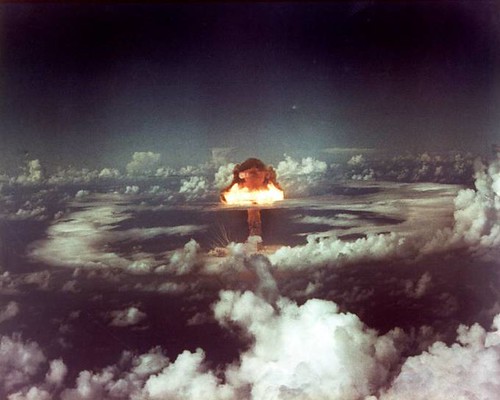 Another tragic yet almost comedic incident of near nuclear devastation occurred in 1980, this time with almost Pythonesque timing. A sudden explosion in a Titan missile base near Little Rock, Arkansas popped the top of a silo off like a cheap champagne cork and tossed the missile’s 9 megaton warhead straight up. Landing some 1,000 feet away, it was later found to be pretty much intact. 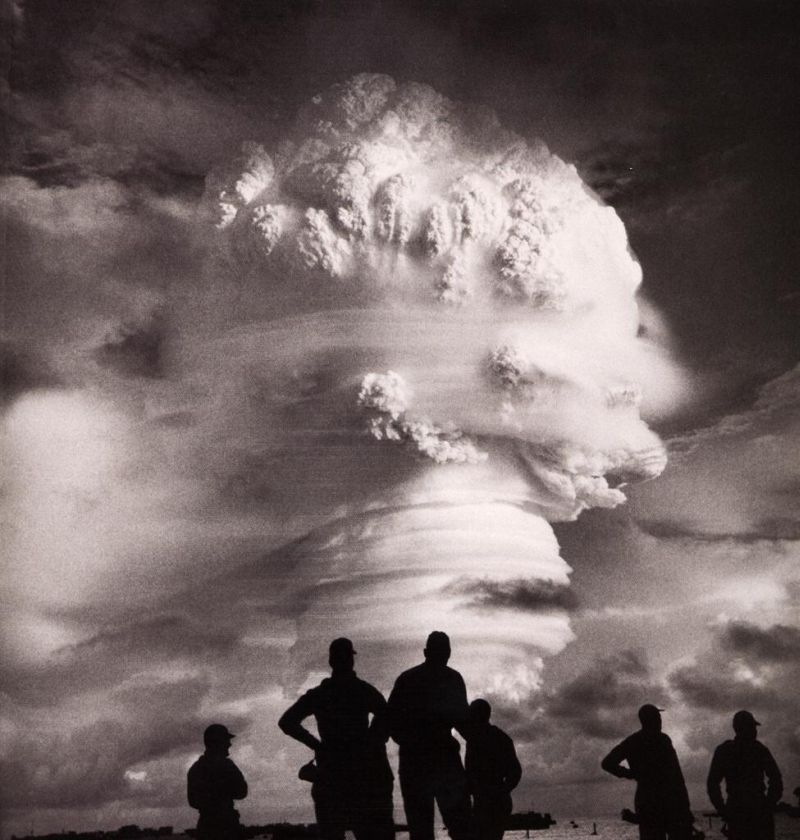 Like said, this little piece is much too short to do into the couple ... no, wait, that isn’t quite fair, more like the dozens and dozens and DOZENS of nuclear weapons mishaps that have livened up the lives of US and international servicemen. But I haven’t even touched on the ones that got away. 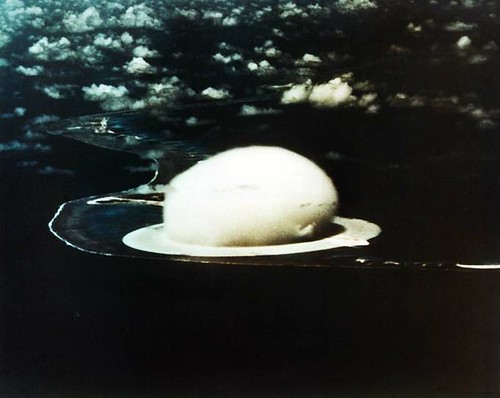 Imagine if you will, some sport fisherman trying to forget a hectic few months at the office by hooking himself a handsome marlin. He’s out there, casting and reeling, casting and reeling, letting those stressful workdays melt off as he imagines how nice that deep sea beauty will look on his office wall, when he has a nibble, then a bite. And, boy, what a bite! In a hot flash of atomic fusion, the ocean for miles around simply vanishes in an expanding bubble of superheated steam. The shockwave travels through the surrounding ocean, a compression sledgehammer that kills everything it encounters, reducing life and the sea floor into component molecules. For a moment, the sun blooms under water. It would be inaccurate to say that there are a few stray thermonuclear devices "floating" around out there because there are certainly more than a few. 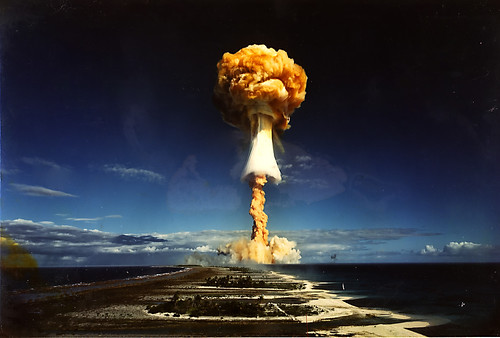 (image credit: Pierre J.) In 1957 a C-124 hauling three atomic devices from Delaware across the Atlantic suddenly developed serious engine trouble. The crew, rather than ride the nukes down to the briny deep, dropped their cargo somewhere between Rehobeth, Delaware, and Wildwood, New Jersey. Got that? Get your charts out and rent yourselves a boat or two, because there’s nuclear treasure to be found out there. The very next year a B-47 smacked into another plane, spilling it’s own atomic cargo into the ocean off of Savannah, Georgia. They looked and they looked but they couldn’t find it. Savannah used to be quite a lovely city .... 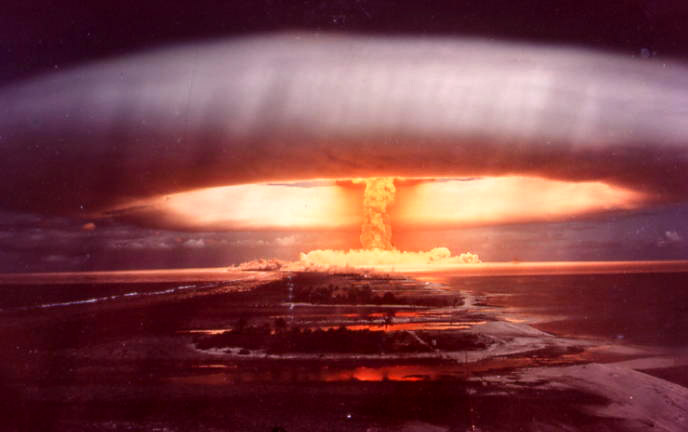 Also in 1956 (not a very good year for the military) another B-47 bomber flying to Europe vanished without a trace. Poof! In addition to one very excellent aircraft, the Air Force also lost a nuclear device. Somewhere sperm whales are using it for a back scratcher: in ‘65 an A-4E jet simply fell off the USS Ticonderoga as it steamed somewhere near the coast of Okinawa and sank in 20,000 feet of water. That little plane was also carrying one hellava large bomb and, somewhere in all that water and pressure, it’s still there.  The Russians have also had their own share of nuclear mishaps, and while we haven’t heard about most of them, the ones we HAVE heard of it are enough to make you pack your dehydrated beans and go live up in the hills. For instance, in 1986 a Soviet Yankee class nuclear sub sort of .... well, sank some 600 miles from Bermuda. In addition to its own nuke power plant, this fine example of Russian engineering was also carrying a few thermonuclear weapons ... 34 of them to be exact.  My all-time favorite, and the one that spawned this little trip to radioactive weirdness, is this little tidbit of Cold War fear. While it doesn’t rank with 34 missing warheads, you’ll see how that doesn’t necessarily mean that this story has what you’d call a happy ending. In 1961 a B-52 decided to do a shake-and-shimmy over North Carolina, dropping two 24-megaton nuclear weapons. One of the little toys released its parachute and glided down to a less-than-gentle landing. 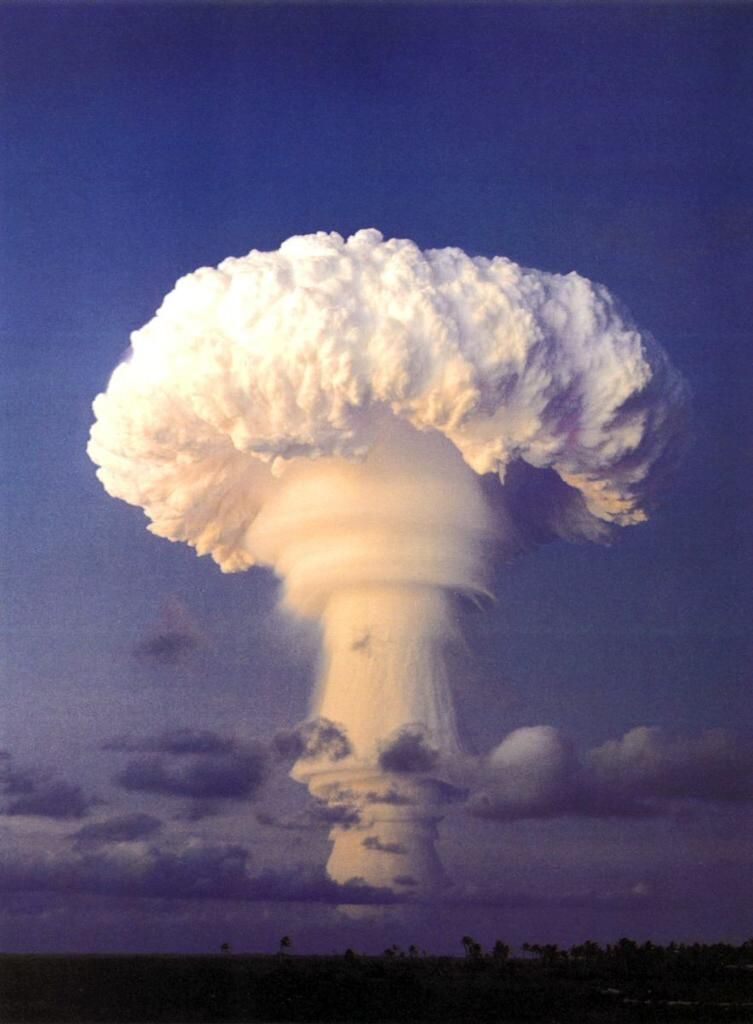 The other device though smacked down somewhere in waterlogged farmland. Not at sea, not in 20,000 feet of water, not "off the coast" of anywhere. Farmland, near North Carolina. Anyone live in North Carolina? Come on, a show of hands - gee, quite a few of you. Isn’t North Carolina a great place to live? You might, though, reconsider because even though this little boo-boo happened over twenty years ago the capable US military never recovered that little gizmo. It’s still out there. Tick, tick, tick, tick .... 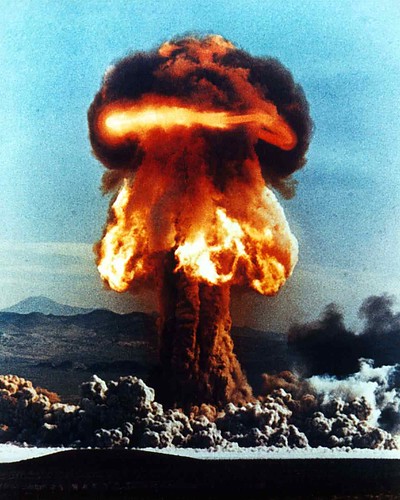 I can hear some of you die-hard optimists mumbling something about "safety" and "redundant backups". Well, you just keep mumbling that comfortable little mantra to yourself while I casually bring up that other bomb, the one that parachuted down. Well, while they found that little fissionable puppy, the guys that inspected it found something very interesting. You see, a device of that type has six safety devices - - and five of them had failed. Good night, America, and all the ships at sea. Sleep tight, don’t let the bed bugs bite, and always remember: accidents will happen. 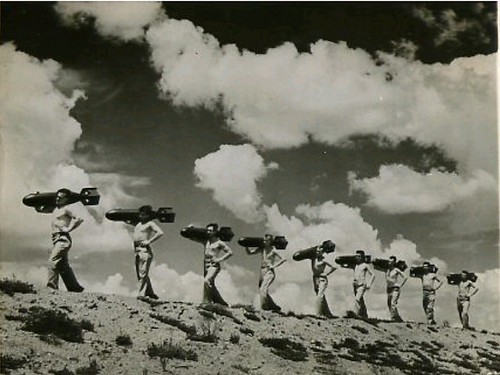 (images credit: vintagephoto) UPDATE: On a positive note, as many comments (thank you) have pointed out: "It is extremely difficult for a nuclear or thermonuclear weapon to go off accidentally. Unless every segment of the explosive shell is triggered simultaneously to create a uniform implosion wave that smoothly compresses your fissionable core to supercriticality, you're going to just get a messy conventional explosion that tosses fissionable material around. (Worst case is a fizzle where you get momentary criticality and a yield equivalent to a few tons.) Any weapon that's been sitting underwater for any length of time is going to be in much too bad a shape to have any meaningful risk of fission detonation." Even as it is an assuring thought, still the massive accumulation of nukes presents tremendous risk, in many cases coming down to "the human error" - read this hair-raising account of close the world came to mutual annihilation in 1983 - Wikipedia article about Stanislav Petrov. Source & further reading: List of Military Nuclear Accidents 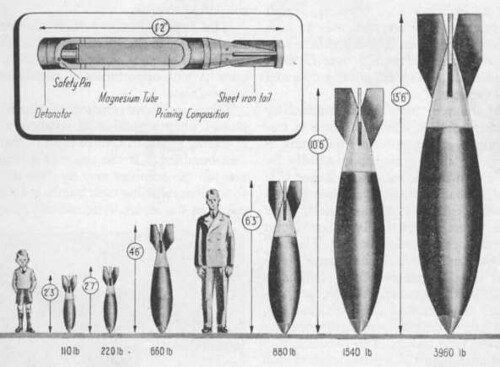 Article by M. Christian, Meine Kleine Fabrik for Dark Roasted Blend. (want to become our co-blogger? write to us, see guidelines here) CONTINUE TO PART 2: BIOCHEMICAL OOPS LIST Permanent Link... Category: History,Weird, Military Related Posts: Cold War: Nuclear Fashion |
RECENT ARTICLES:

|
Visual Caffeine #8 Visual Caffeine, Issue 8 A thrilling blend of art, myths and technology |

|
Visual Caffeine #7 Visual Caffeine, Issue 7 A thrilling blend of art, myths and technology |

|
Art Deco Imperial Dreams: Art Deco Update Wings, Gears, & Glamorous Ladies |

|
1970s SciFi DRB Pics-of-the-Day Grand Space Adventure 1970s Art |
"Dark Roasted Blend" - All Kinds of Weird and Wonderful Things, Discovered Daily!"
DRB is a top-ranked and respected source for the best in art, travel and fascinating technology, with a highly eclectic presentation. Our in-depth articles in many categories make DRB a valued online magazine, bringing you quality info and entertainment every time you visit the site - About DRB
Connect with us and become part of DRB on Facebook and Twitter.
YOUR COMMENTS::
|
|
|
|
SF ART & BOOK REVIEWS: Don't miss: The Ultimate Guide to NEW SF&F Writers! Fiction Reviews: Classic Cyberpunk: Extreme Fiction Short Fiction Reviews: Lovecraft's "At the Mountains of Madness" (with pics) New Fiction Reviews: The Surreal Office |
READ OTHER RECENT ARTICLES:

|
Abandoned, Dieselpunk DRB Pic-of-the-Day Abandoned: Streamlined Three-wheeler |

|
Visual Caffeine #6 Visual Caffeine, Issue 6 A thrilling blend of art, myths and technology |

|
Visual Caffeine #5 Visual Caffeine, Issue 5 A thrilling blend of art, myths and technology |

|
Hellish Weather on Other Planets
Wild, Untamed, and Uncut |

|
Medieval Suits of Armor
Metal Body Suits vs. Weapons of Medieval Destruction |

|
World's Strangest Theme Parks
Amusement to the (twisted) extremes! |

|
Enchanting Victorian Fairy Tale Art
"Then world behind and home ahead..." |

|
Adorable Pedal Cars
Collectable Pedal Vehicles Showcase |

|
Japanese Arcades: Gundam Pods & Other Guilty Pleasures These machines have gone up to the next level |

|
Modernist Tallinn Architecture Delicious blend of old and new! |

|
Early Supercomputers: A Visual Overview "Computers in the future may weigh no more than 1.5 tons" |

|
Futuristic Concept Cars of the 1970-80s French, Italian & Japanese rare beauties |

|
Epic 1970s French Space Comic Art DRB Time-Slice: Valérian and Laureline |

|
The Trees Are Escaping! The Abandoned Prison in French Guiana "Great Escape" from the Devil's Island |
|
FULL ARCHIVES (with previews, fast loading): 2022/16 2015/14 2013 2012 2011 2010 2009 2008 2007 2006 Link Lattes Feel-Good & Biscotti Issues |
|
CATEGORIES:
Feel-Good! | airplanes | animals | architecture | art | auto | boats | books | cool ads | famous | futurism | food
gadgets | health | japan | internet | link latte | military | music | nature | photo | russia | steampunk
sci-fi & fantasy | signs | space | technology | trains | travel | vintage | weird | abandoned













































31 Comments:
I think I need to go do some laundry...
i couldn't decide whether to laugh out loud or take a good long drink... maybe both.
Funniest blog entry in a long time!
there is a small addendum to that story of the 5 failed safeties (out of six) .. unfortunately i never could find independent confirmation except in the book of a very respected austrian journaillist ... but perhaps a blogger can help ..
that incident prompted the US government to start a masive research project to improve the safeties in nuclear devices .. the results of this research project were quickly incorporated in the existing bombs .. AND .. here it comes:
the results were also supposedly leaked to the government of the CCCP because of the fear that a similar accident in russia could perhaps start an accidental war ..
Very cool, Anonymous! Wish I had that info when I did the piece -- would have been a great addition. I, for one, am packing my beans and heading for the hills .. and that's NOT taking into account the technological 'expertise' of countries like Russia, France, Pakistan, India (shudder)
you are my FUD-bitch, you spread the Fear, Uncertainty, and Doubt and I reap the rewards of blowing more carbon with less efficiency.
Lets see a page about all the poor little children that died before we discovered polio vaccines.
How about a page about how many people die in car accidents every year oh, 40,000+ is to overwhelming for you.
Get a life and appreciate what we DO have - safe thermonuclear power, safe lands to live in from having thermonuclear warheads.
...that's one way to look at things
I do kinda hate to break it to you, but a drop, collision, or even explosion won't create the nuclear fission/fusion explosion that is the worry about nuclear weapons. The basic idea of a fission explosion is wrapping a sphere with explosives so the sphere will implode quickly enough that it will explode. Thermonuclear added more stages to create a bigger secondary explosion. But the difficultly in creating a spherical implosion is what prevents the average terrorist from making one. The Rosenburgs were executed when they passed secrets dealing with this to the Russian. That same difficulty is what prevents an accidental nuclear explosion.
Don't spread FUD. There are very legitimate fears you sort of addressed: Random weapons-grade materials and pre-made bombs missing, and the possibility of the conventional explosives spreading radioactive particles that really could cause alot of death. Plutonium has a lethal toxicity easily ranked in the parts per billion.
So there is definately legitimate concerns - just don't blow them to far out of porportion. I'd hate to see you have to get sued to pay alot of people's laundry bills.
The only way to set off a fission bomb is for the outer shell of conventional warheads to all detonate within a few microseconds of each other. This just wont happen in the case of a drop or some other mishap. These devices require finely tuned electronic circuits to initiate simultaneous detonation.
I like your government-bashing energy, but please use it somewhere where the government is actually at fault.
Great stuff! It's staggering to think about all these near-misses...
My dad dropped a nuclear bomb while loading it on a plane on a Turkish runway during the Vietnam War. It rolled down the runway before they caught up to it. The officer who saw it said not to tell any one, because such accidents make it all the way to the president.
"Luckily for the crew they managed to drop their bombs, which fell 8,000 feet, landing with a bang off the coast of British Columbia"
So that's why BC Bud grows so fast... :p
Great entry, and I don't think it's spreading of fear as much as it is sharing of information. Thank you.
You make a good point--accidents do happen.
But your post is alarmist. It's clear that you're trying to maximize fear. I don't think that's very responsible, and it shows a clear misunderstanding of the technologies you discuss.
The public's fear of the atom is reminiscent of the fear of electricity in the late 19th and early 20th century. Why don't you write a post about the dangers of electricity and associated accidents?
We're not going to be driving hydrogen cars tomorrow. Get used to the fact that harnessing the power of the atom is the most promising way forward /right now/.
I worked with one of the guys on the crew at the silo near Little Rock, AR, and he tells a bit of a different story.
Basically, someone dropped a huge wrench from the top of the silo, and as it bounced between the wall and the missile, it punctured the fuel tank. As the rocket fuel leaked out, the tank lost pressure and the rocket finally lost its support, crumpled, and exploded.
But this didn't happen suddenly. The leak took hours and hours to hit that critical drop in pressure. They evac'd the silo and everyone near it, but said nothing to the people living just miles away.
Still just as scary, though...
this article shows a complete lack of understanding of how nuclear warheads work, as well as a blatant misuse of the word "thermonuclear" (that only applies to fusion, not fission). It's completely inaccurate to imply that any of those had a chance of going off.
You couldn't be more wrong on the story about two bombs landing in waterlogged famrland. A quick internet search reveals thatwhile two weapons were lost when the plane malfunctioned, the second one is not out there going "tick tick tick". In fact, they found the impact crater the bomb made and recovered a substantial portion of the material from the bomb after digging up to 22'. Heavy rainfall forced the abandonment of the recovery and the Air Force bought the land to prevent further digging. See this link for a factual description of events, it's much than this bullshit.
http://www.ibiblio.org/bomb/hansen_doc.html
As JJ said, it is extremely difficult for a nuclear or thermonuclear weapon to go off accidentally. Unless every segment of the explosive shell is triggered simultaneously to create a uniform implosion wave that smoothly compresses your fissionable core to supercriticality, you're going to just get a messy conventional explosion that tosses fissionable material around. (Worst case is a fizzle where you get momentary criticality and a yield equivalent to a few tons.) Any weapon that's been sitting underwater for any length of time is going to be in much too bad a shape to have any meaningful risk of fission detonation.
This refers to implosion weapons, of course -- uranium-gun weapons are more rugged and mechanically straightforward, but they're also inefficient and have not been a part of the US arsenal for many decades.
Accidental detonation of a fusion weapon is even more vastly unlikely, since it requires a clean and efficient detonation of the fission primary to reach the temperatures necessary to initiate a fusion burn in the deuterium fuel.
Two other points: David Kraft, if only we had safe thermonuclear energy! So far the only way anyone's figured out to get more energy out a fusion reaction than you put in is a bomb, and the practical applications are limited. We've got plenty of (more or less safe) nuclear power, but no thermonuclear.
And, regarding leaking safeguard technology to the Soviets: certainly sounds plausible enough. I know that after PAL (Permissive Action Link) technology was developed in the US to prevent unauthorized launch or detonation of weapons, it was quite intentionally leaked to the Soviet Union, and to China when they began to develop their arsenal. The idea was to minimize the chance of a rogue military commander launching his weapons at the U.S. without authorization.
Thank you for these great comments. I've updated the article, see above.
Thanks to all of you great folks for your fun and/or informative comments on my little piece on nuclear weapon boo-boos. I especially appreciate the technical info that’s been put out, especially since I’m a writer and not an engineer. Avi is quite correct to place an amendment to the piece about how unlikely an actual nuclear detonation is. I also just learned (thanks Jon) that the supposedly “tick, tick, ticking” bomb that was dropped on North Carolina was recovered – though that it impacted at 700 mph doesn’t make me feel any better.
However (and didn’t you know this was coming) I still feel the spirit of the piece is still very much intact. I am not anti-government, anti-military, anti-nuclear, anti-America, or anti-much-of-anything: I just wanted to share with folks who are into odd and unusual history that there have been a considerable number of pants-staining mistakes made regarding the most dangerous device ever created.
Or, to put it in bad movie language: “I don't know what's scarier, losing a nuclear weapon or that it happens so often there's actually a term for it,” from Broken Arrow, starring the world’s favorite Scientologist, John Travolta.
In a follow-up piece I’ll be talking about something REALLY scary: screw-ups involving biological and chemical weapons.
Ciao,
M.Christian
Don't forget the Palomares incident..
http://en.wikipedia.org/wiki/Palomares_H-Bomb_Incident
Wow ... as scary as the article itself is, I can't believe the sheer naivete of the comments here. The people who've said either that losing nukes is no biggie, or that nuclear power is safe, need to do more research &/or seek professional help.
Nukes are not candy. Once lost, they can easily fall into the hands of unsavoury folks ... or simply leak extremely dangerous & long-lived isotopes into the environment. Explode, no - but they can still kill.
We have yet to invent a foolproof storage system for n-waste, & I doubt any such system is even physically possible. Wind, tidal & solar are all cheap & clean alternatives. We have no excuses left for continuing to neglect them in 2007.
Go tell former residents of Chernobyl how "safe" nuclear power is - they'll be relieved to hear it - the ones not dead of cancer yet, that is. The immediate death toll from that ONE accident is unknown, but indirect deaths from carcinomas likely number in the millions.
We need to avoid use of a technology that's both deadly & obscenely expensive, while we still can.
jim, no one has said that losing nukes is "no biggie". Most of these are reasonable comments pointing out that fears of a nuclear explosion from dropping a warhead are unfounded.
And before you cast stones, you should get your own facts straight. Regarding Chernobyl, you say "The immediate death toll from that ONE accident is unknown, but indirect deaths from carcinomas likely number in the millions."
Rubbish. While certainly a horrible tragedy that should never have happened, the death toll is estimated to be less than 10,000.
Your "glowing" test area is nothing more than a broad, largely empty desert valley with some roads and an old farm house. Of course, if you know the history of it, it really is amazing, but at first glance it is nothing much to look at.
I love the whiners crying "waa FUD waa". Wonder how many "terrists" would love to get their hands on one, just for the scrap inside? You FUD-monkeys would shit your panties if one was found on your block.
Cool article. Made the FUD wieners weep.
I loved reading all of this. My husband worked at Ellsworth with the trailers & equipment they use to load & repair the B-1b Lancer. Not nuke carrying capable right now, but in 24hrs they can convert the whole fleet back to being able to carry nukes. :P
Bombs in general, information & such is interesting to me at the moment, My husband is going through EOD school here at Eglin AFB. For those of you who do not know what EOD is, it is Explosive Ordinance Disposal. Them guys who disarm those roadside bombs, IEDs and all that sort of stuff.
So I get to hear about the various things he can tell me, without breaking the rules. Interesting to say the very least!
Avi, maybe one of your folks who do articles or yourself could do one specifically on our EOD troops?
My favorite "Oops..." was during the early days of the hydrogen bomb, when they were massive devices.
A bomber parked on the apron at an Air Force base in Alaska was undergoing some minor maintenance when a short released the shackles on a fusion device.
The bomb crashed through the bomb bay doors and partially embedded itself in the tarmac. Making recovery a bit difficult. They knew where it was, but how do you pry a multi-tonne hydrogen bomb out of the pavement? (Very carefully. :-)
I have a short article on fission and fusion weapons here:
http://www.dcr.net/~stickmak/JOHT/joht17bang.htm
At first I was thinking::
"Ha, I'll just live up in the space station......"
But noooooooo..... Than I read the other article about one-in-a-million collisions. Now I'm not so much thinking as building an underground facility to survive.
I backed into a bomb with a front-end loader. It fell into a ditch and we drove away...FAST lolol
PSSST: dont tell anyone
I love a good story of lost nukes just waiting to go off, it reminds me of the countless horrible ways you could die each second. It just goes to show you should stop spending 40 minutes picking an outfit or scrubbing one little spot on your sink or warring about all toughs little things because why your doing that. Tick, tick,tick, tick.... BOOM!
Castle Bravo. Nuff said.
It is my understanding that the B36 its nuclear weapons in a partially disassembled state, with the fissionable core not in the weapon, but in a safety cage stowed elsewhere in the bomb bay.
As the bomber approached target, the weapons officer and the bombardier would enter the bomb bay, install the core, finish the assembly to mechanically arm the weapon, and finally remove the safety pins that prevented the weapon from being released from the aircraft.
(IIRC, they were trained to be able to do this in less than five minutes per weapon - many greatly exceeded this requirement.)
Only after they had done this could the weapon be dropped and explode.
It is my understanding that the weapons jettisoned off Vancouver Island did not have the cores installed, and in fact, there may not have been a full load of cores even aboard.
Also, this may have been the incident where, in order to prevent recovery of the weapons by hostile persons, the weapons officer performed a partial arm without installing the core, and released the weapon so that it self-destructed by detonating the conventional explosive component.
If so, the weapons were not recovered because they were observed to explode before reaching the ocean.
The cores, OTOH, were recovered with the aircraft.
Drat . . . revise the first paragraph above to read:
It is my understanding that the B36 CARRIED its nuclear weapons in a partially disassembled state, with the fissionable core not in the weapon, but in a safety cage stowed elsewhere in the bomb bay.
Post a Comment
<< Home